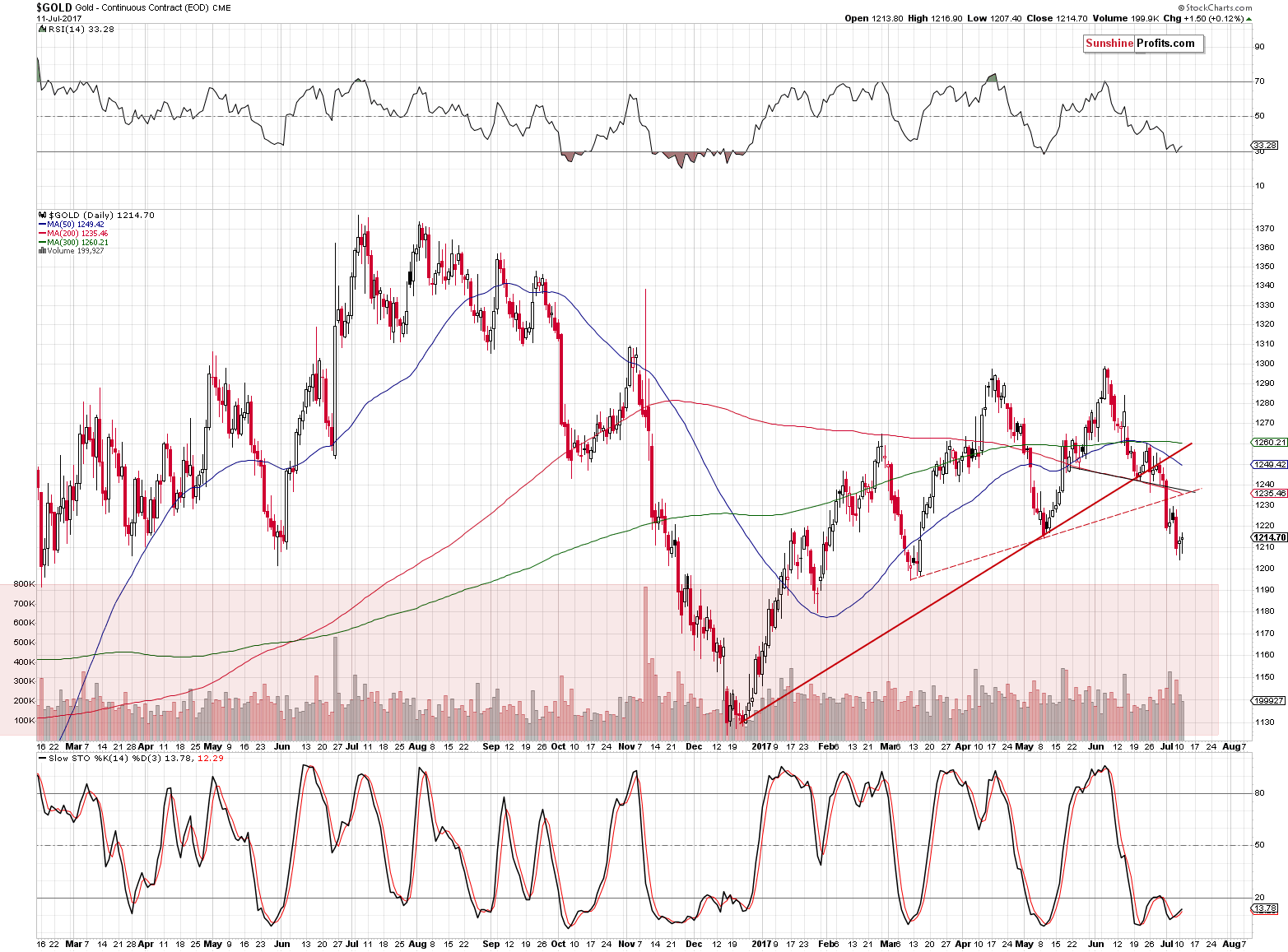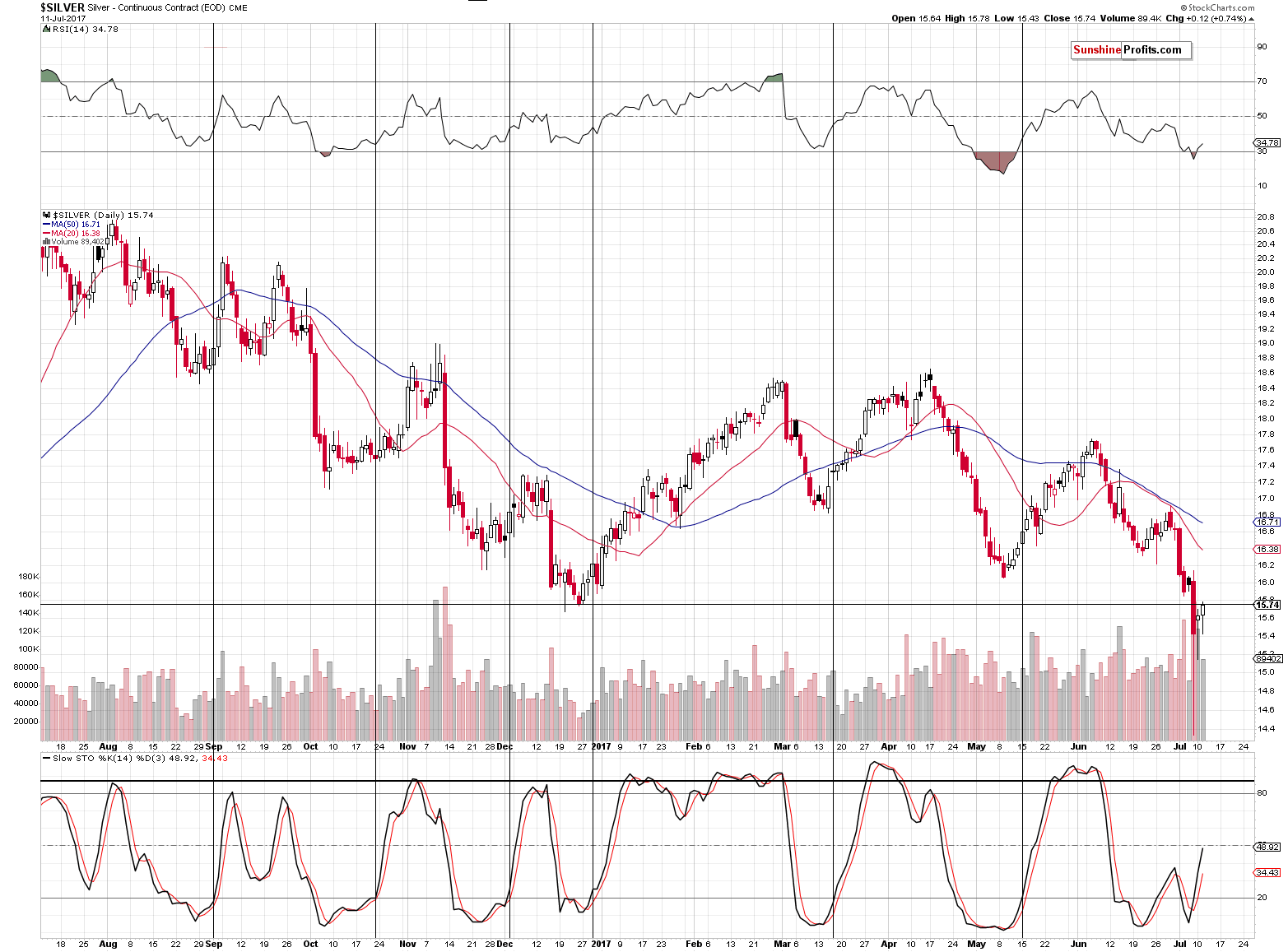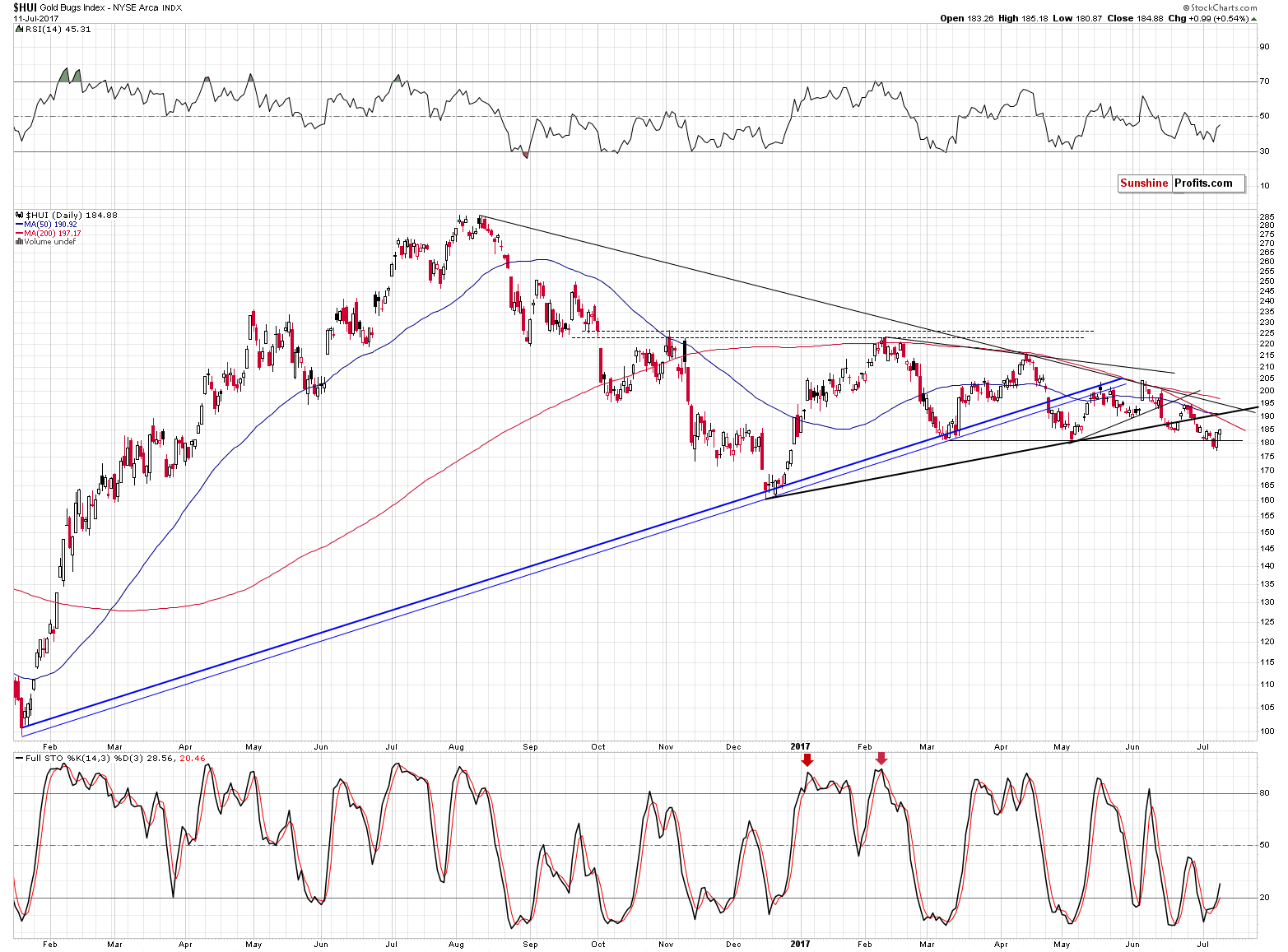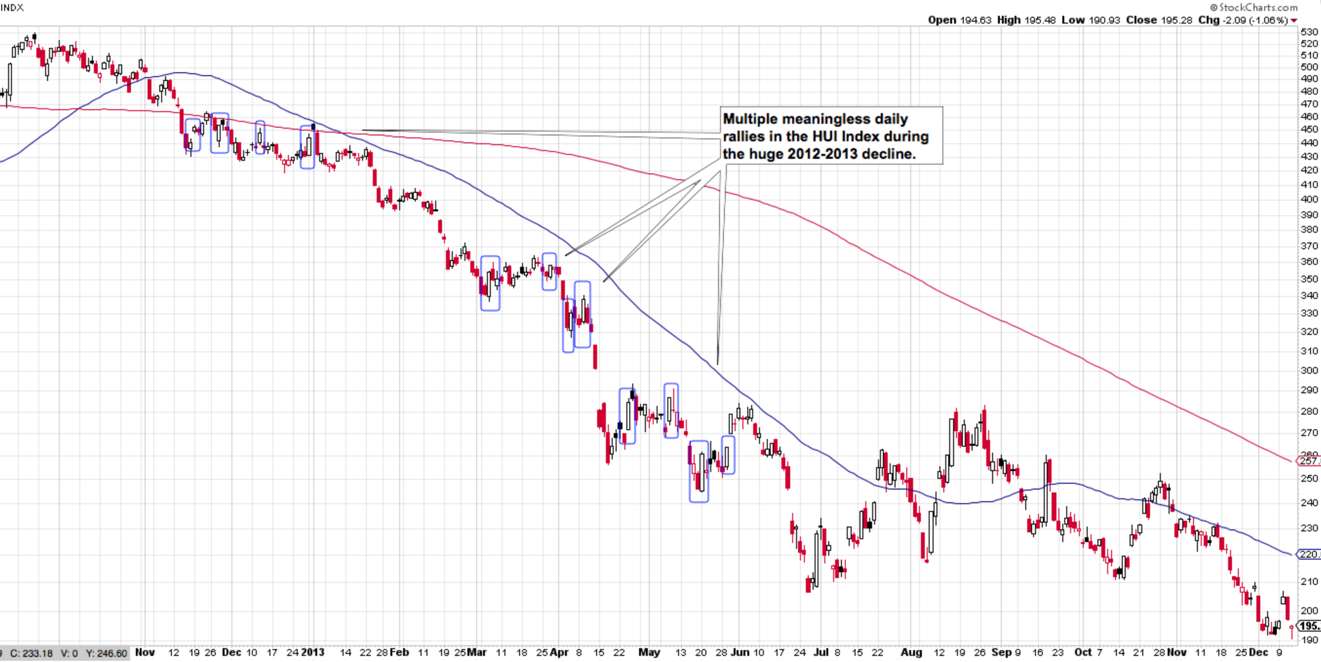Briefly: In our opinion, full (150% of the regular full position) speculative short positions in gold, silver and mining stocks are justified from the risk/reward perspective at the moment of publishing this alert.
Gold, silver and mining stocks continued to move higher yesterday – is the rally something to be concerned with or does it not change anything regarding the outlook?
In short, it doesn’t appear too significant and the charts provide details. Let’s with the one featuring gold (chart courtesy of http://stockcharts.com).

In yesterday’s alert, we wrote the following:
The reversal in gold was relatively small and it was accompanied by relatively small volume. In the case of the reversals, big volume is an important sign as it shows that the buying power overwhelms sellers. In the case of relatively small volume, it appears more likely that gold bounced and didn’t manage to decline before the end of the session. The closing price is another factor that confirms the former scenario – gold closed below its May low (in terms of the closing prices).
Gold moved just a little higher yesterday and the volume that accompanied this tiny upswing was even lower than the one seen on Monday. Moreover, gold once again closed below the May low (in terms of the closing prices). Consequently, yesterday’s session didn’t change anything and the above comments remain up-to-date and the outlook remains bearish.

The situation is similar in the case of silver. The white metal didn’t close the session above its December low (in terms of daily closing prices) and thus nothing changed from the technical point of view. Our yesterday’s comments remain up-to-date:
The volume in silver was relatively bigger, but the closing price level also suggests that the rally was more of a bounce than of a true reversal – the white metal closed the session not only below the May low, but also below its December 2016 low. Yesterday’s action still appears to be a verification of the breakdown, especially that silver moved lower in today’s pre-market trading.

The situation didn’t change in the case of the mining stocks either. In yesterday’s alert, we wrote the following:
Gold stocks moved higher yesterday and the session’s candlestick is quite visibly bullish. Is there anything not to like about this “bullish” signal? A couple of things – let’s start with what’s visible on the above chart and that is that the possible upside target is very limited – the declining, rising and short-term declining resistance lines are very close, which would likely keep the rally in check, if one was to follow.
The other thing is that it was just one session of strength and one swallow doesn’t necessarily make a summer. Surely, one could argue that in the case of an invalidation of a breakdown, one session is enough to make a difference, but let’s keep in mind that the previous low is not the only thing that gold stocks broke below. Miners moved below the rising support line based on the previous important lows and this line was not invalidated and miners did not even move close to it.
Most importantly, however, we know how the HUI Index performed during the 2012-2013 decline.

It turns out that there were multiple daily rallies within the decline. Which one of them was worth taking action on? None of them. It was better to wait out the following small corrections and profit on the huge downtrend.
Naturally, one could say that the current decline is not like the 2013 decline, but last week’s action in silver suggests otherwise.
In yesterday’s trading, the HUI Index moved higher by less than 1 index point and the outlook didn’t change at all. Even if we see a move higher this week, it’s not likely to be anything significant and the big decline is likely to follow shortly anyway.
All in all, there is little that we can add to yesterday’s alert as nothing really seems to have changed based on yesterday’s session and what we wrote yesterday remains up-to-date. Today’s outlook can also be summarized in the same way as yesterday:
Summing up, the outlook for the precious metals market is very bearish and it appears that the decline will take on a much more visible form in the coming weeks, even though a small (!) upswing in the next few days would not surprise us. While it does present an excellent trading opportunity (and the previously-entered short positions are already profitable), let’s keep in mind that the biggest gains in the coming years will be made with the investment capital and the upcoming decline will very likely provide us with an epic buying opportunity – that’s something worth preparing for.
On a side note, we just wrote the third article of the Preparing for THE Bottom in Gold series, in which we discuss the target for the gold to silver ratio. We encourage you to read it – this ratio is one of the things that we look at each day even though we don’t discuss it that often (after all, the situation in it doesn’t change frequently).
As always, we will keep you – our subscribers – informed.
To summarize:
Trading capital (supplementary part of the portfolio; our opinion): Short positions (150% of the full position) in gold, silver and mining stocks are justified from the risk/reward perspective with the following stop-loss orders and initial target price levels / profit-take orders:
- Gold: exit-profit-take level: $1,063; stop-loss: $1,317; initial target price for the DGLD ETN: $81.88; stop-loss for the DGLD ETN $44.57
- Silver: initial target price: $13.12; stop-loss: $19.22; initial target price for the DSLV ETN: $46.18; stop-loss for the DSLV ETN $17.93
- Mining stocks (price levels for the GDX ETF): initial target price: $9.34; stop-loss: $26.34; initial target price for the DUST ETF: $143.56; stop-loss for the DUST ETF $21.37
In case one wants to bet on junior mining stocks' prices (we do not suggest doing so – we think senior mining stocks are more predictable in the case of short-term trades – if one wants to do it anyway, we provide the details), here are the stop-loss details and initial target prices:
- GDXJ ETF: initial target price: $14.13; stop-loss: $45.31
- JDST ETF: initial target price: $417.04; stop-loss: $43.12
Long-term capital (core part of the portfolio; our opinion): No positions (in other words: cash)
Insurance capital (core part of the portfolio; our opinion): Full position
Important Details for New Subscribers
Whether you already subscribed or not, we encourage you to find out how to make the most of our alerts and read our replies to the most common alert-and-gold-trading-related-questions.
Please note that the in the trading section we describe the situation for the day that the alert is posted. In other words, it we are writing about a speculative position, it means that it is up-to-date on the day it was posted. We are also featuring the initial target prices, so that you can decide whether keeping a position on a given day is something that is in tune with your approach (some moves are too small for medium-term traders and some might appear too big for day-traders).
Plus, you might want to read why our stop-loss orders are usually relatively far from the current price.
Please note that a full position doesn’t mean using all of the capital for a given trade. You will find details on our thoughts on gold portfolio structuring in the Key Insights section on our website.
As a reminder – “initial target price” means exactly that – an “initial” one, it’s not a price level at which we suggest closing positions. If this becomes the case (like it did in the previous trade) we will refer to these levels as levels of exit orders (exactly as we’ve done previously). Stop-loss levels, however, are naturally not “initial”, but something that, in our opinion, might be entered as an order.
Since it is impossible to synchronize target prices and stop-loss levels for all the ETFs and ETNs with the main markets that we provide these levels for (gold, silver and mining stocks – the GDX ETF), the stop-loss levels and target prices for other ETNs and ETF (among other: UGLD, DGLD, USLV, DSLV, NUGT, DUST, JNUG, JDST) are provided as supplementary, and not as “final”. This means that if a stop-loss or a target level is reached for any of the “additional instruments” (DGLD for instance), but not for the “main instrument” (gold in this case), we will view positions in both gold and DGLD as still open and the stop-loss for DGLD would have to be moved lower. On the other hand, if gold moves to a stop-loss level but DGLD doesn’t, then we will view both positions (in gold and DGLD) as closed. In other words, since it’s not possible to be 100% certain that each related instrument moves to a given level when the underlying instrument does, we can’t provide levels that would be binding. The levels that we do provide are our best estimate of the levels that will correspond to the levels in the underlying assets, but it will be the underlying assets that one will need to focus on regarding the signs pointing to closing a given position or keeping it open. We might adjust the levels in the “additional instruments” without adjusting the levels in the “main instruments”, which will simply mean that we have improved our estimation of these levels, not that we changed our outlook on the markets. We are already working on a tool that would update these levels on a daily basis for the most popular ETFs, ETNs and individual mining stocks.
Our preferred ways to invest in and to trade gold along with the reasoning can be found in the how to buy gold section. Additionally, our preferred ETFs and ETNs can be found in our Gold & Silver ETF Ranking.
As a reminder, Gold & Silver Trading Alerts are posted before or on each trading day (we usually post them before the opening bell, but we don't promise doing that each day). If there's anything urgent, we will send you an additional small alert before posting the main one.
=====
Latest Free Trading Alerts:
In the first part of the Preparing for THE Bottom series, we emphasized the need to be sure to stay alert and focused in the precious metals market, even though it may not appear all that interesting. We argued that preparing for the big moves in gold that are likely to be seen later this year should prove extremely worth one’s while. In the second part of the series, we discussed when, approximately, one can expect the key bottom in gold to form (reminder: this winter appears a likely target).
Preparing for THE Bottom: Part 3 – Gold to Silver Ratio
Yesterday, President Donald Trump’s eldest son released an email chain which suggests that Russia wanted to support Trump’s presidential campaign. What does it imply for the gold market?
Bitcoin hasn’t decisively broken down below the $2,400 level. However, we’ve seen a move below the 23.6% retracement level (at $2,487). What might this mean?
=====
Hand-picked precious-metals-related links:
HSBC says downside risks for gold are looking 'increasingly limited'
India's June gold imports spike as buyers tried to beat higher sales tax
Rio Tinto in search of the next Escondida mine in Chile
Polyus grabs all of legendary Sukhoi Log gold deposit
=====
In other news:
Yellen to speak: stocks up, dollar sluggish
U.K. Pay Falls Despite Lowest Unemployment Since 1975
EU project 'alive and kicking'; Brexit has inspired non-members to join, says IMF's Lagarde
Bank of England's Michael Saunders: 'Prepare for higher interest rates'
These Numbers Show the Huge Challenges Now Facing OPEC Members
BP CEO says he's not expecting big rise in oil price, says market balanced on a daily basis
=====
Thank you.
Sincerely,
Przemyslaw Radomski, CFA
Founder, Editor-in-chief, Gold & Silver Fund Manager
Gold & Silver Trading Alerts
Forex Trading Alerts
Oil Investment Updates
Oil Trading Alerts



